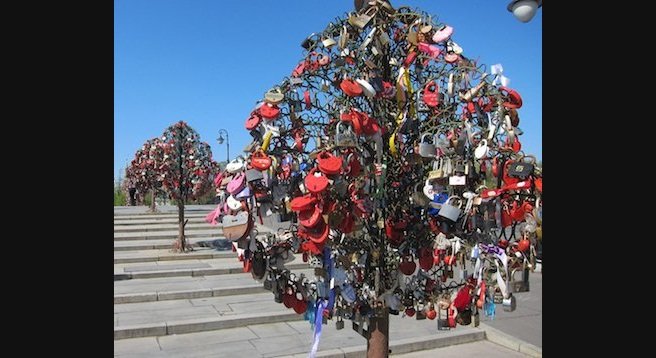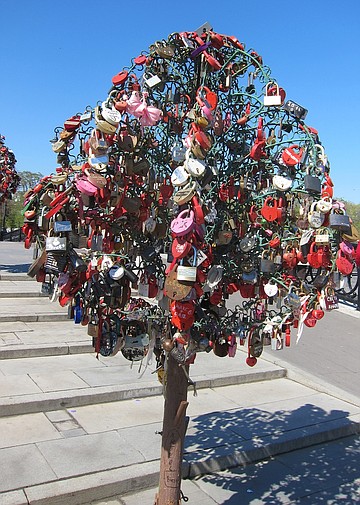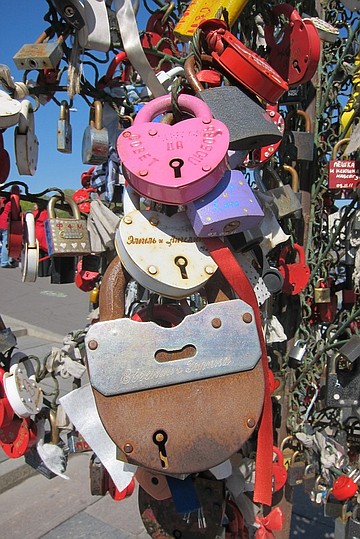 Facebook
Facebook
 X
X
 Instagram
Instagram
 TikTok
TikTok
 Youtube
Youtube

There is an old Russian folktale that says that in days gone by, young married couples were locked inside a granary shed for privacy during their wedding night.
True or not, it’s a story that has found new life on the streets of Moscow.
As the story was first told to me, several years ago a newlywed couple revived this tradition when they sealed their vows by placing a padlock on the rail of the Luzhkov Bridge that spans a canal of the Moscow River in the center of the city and threw the key into the water symbolizing the permanence of their union. It was said that if either member of the union wished to end it, they had to dive into the freezing cold and extremely polluted water to retrieve the key to the lock.
The story went viral, and in a few weeks the bridge railings were covered with hundreds of locks in a city where weddings are usually big splashy affairs with stretch limos, colorful tuxedos and gallons of champagne. However, the city fathers decided the bridge full of padlocks had become an eyesore, and they were cut off.
But that only increased the fervor of young Muscovites in love. Russians are raised on folklore and fairytales, and fell in love with the idea of using the locks to symbolize permanent love – especially when it involved finding one particular key among thousands of others at the bottom of the waterway in order to end it. As the tradition spread, the divorce rate in the city actually dropped. (While this is probably a wives' tale, it’s a good one.)

Realizing the popularity of this custom, the city erected a symbolic tree made of steel on which the couples were encouraged to place their locks (left). This became so popular that within a couple of years, the bridge was packed with trees and the idea was extended along the entire street next to the canal.
Today, there are ten different streets in Moscow where newly hitched couples go on their blessed days to visually present their love to the world by placing their padlocks on the steel trees. This scene of metallic shrubbery resembles a scene straight out of Edward Scissorhands.
The trees each have hundreds of padlocks, some modern and new, but the most popular seem to be old – and the older the better. Leading the way are ancient-looking padlocks the size of a human fist that require an old church key, harking back to medieval times. Many are painted bright colors, and almost all of them are hand-painted with the couple's names and date of their wedding. The trees look like metallic cotton candy or steel snow cones.
I was told that so many keys have been thrown into the river, along with shattered champagne glasses, that the canals must now be dredged regularly to insure the continued passage of the popular boats that ferry tourists along the waterway.

While the Luzhkov bridge continues to fill with locks, more individual couples have begun to express their love by placing their locks on the fence rail in front of the popular Cathedral of Christ the Savior. Now the city has workmen standing by with bolt cutters who remove all the locks placed there each day in order that the cathedral is not overwhelmed by them. In my Moscow wanderings I have found locks in remote, out-of-the-way places where you'd never think of finding them – private statements of love not meant for the general public.
While following an actual tourist map that shows the location of these “wedding-lock streets,” I came upon an enterprising gentleman with a stall that not only sold brightly colored, brand-new locks made to look old, but also bottles of vodka to cement the occasion with a traditional toast.
In my five days in the city I was astounded by the sheer number of wedding parties I witnessed – almost all of them in stretch limos that would be at home in Beverly Hills, and all of them making a stop to add their padlock to the ever-increasing collection.
Moscow is a city rapidly changing: from dour-looking cement blockhouses symbolizing architecture under communism to a metropolis of modern, glistening steel-and-glass high rises. While the once-gloomy city transitions from its greyish past into a world of glitzy high fashion, this old-time tradition is not only holding its own, but gaining in popularity.
Editor's note: other European cities, like Cologne, Germany, have taken up the tradition of placing locks on bridges to symbolize lifelong love: see this 2/12 Reader Travel story.


There is an old Russian folktale that says that in days gone by, young married couples were locked inside a granary shed for privacy during their wedding night.
True or not, it’s a story that has found new life on the streets of Moscow.
As the story was first told to me, several years ago a newlywed couple revived this tradition when they sealed their vows by placing a padlock on the rail of the Luzhkov Bridge that spans a canal of the Moscow River in the center of the city and threw the key into the water symbolizing the permanence of their union. It was said that if either member of the union wished to end it, they had to dive into the freezing cold and extremely polluted water to retrieve the key to the lock.
The story went viral, and in a few weeks the bridge railings were covered with hundreds of locks in a city where weddings are usually big splashy affairs with stretch limos, colorful tuxedos and gallons of champagne. However, the city fathers decided the bridge full of padlocks had become an eyesore, and they were cut off.
But that only increased the fervor of young Muscovites in love. Russians are raised on folklore and fairytales, and fell in love with the idea of using the locks to symbolize permanent love – especially when it involved finding one particular key among thousands of others at the bottom of the waterway in order to end it. As the tradition spread, the divorce rate in the city actually dropped. (While this is probably a wives' tale, it’s a good one.)

Realizing the popularity of this custom, the city erected a symbolic tree made of steel on which the couples were encouraged to place their locks (left). This became so popular that within a couple of years, the bridge was packed with trees and the idea was extended along the entire street next to the canal.
Today, there are ten different streets in Moscow where newly hitched couples go on their blessed days to visually present their love to the world by placing their padlocks on the steel trees. This scene of metallic shrubbery resembles a scene straight out of Edward Scissorhands.
The trees each have hundreds of padlocks, some modern and new, but the most popular seem to be old – and the older the better. Leading the way are ancient-looking padlocks the size of a human fist that require an old church key, harking back to medieval times. Many are painted bright colors, and almost all of them are hand-painted with the couple's names and date of their wedding. The trees look like metallic cotton candy or steel snow cones.
I was told that so many keys have been thrown into the river, along with shattered champagne glasses, that the canals must now be dredged regularly to insure the continued passage of the popular boats that ferry tourists along the waterway.

While the Luzhkov bridge continues to fill with locks, more individual couples have begun to express their love by placing their locks on the fence rail in front of the popular Cathedral of Christ the Savior. Now the city has workmen standing by with bolt cutters who remove all the locks placed there each day in order that the cathedral is not overwhelmed by them. In my Moscow wanderings I have found locks in remote, out-of-the-way places where you'd never think of finding them – private statements of love not meant for the general public.
While following an actual tourist map that shows the location of these “wedding-lock streets,” I came upon an enterprising gentleman with a stall that not only sold brightly colored, brand-new locks made to look old, but also bottles of vodka to cement the occasion with a traditional toast.
In my five days in the city I was astounded by the sheer number of wedding parties I witnessed – almost all of them in stretch limos that would be at home in Beverly Hills, and all of them making a stop to add their padlock to the ever-increasing collection.
Moscow is a city rapidly changing: from dour-looking cement blockhouses symbolizing architecture under communism to a metropolis of modern, glistening steel-and-glass high rises. While the once-gloomy city transitions from its greyish past into a world of glitzy high fashion, this old-time tradition is not only holding its own, but gaining in popularity.
Editor's note: other European cities, like Cologne, Germany, have taken up the tradition of placing locks on bridges to symbolize lifelong love: see this 2/12 Reader Travel story.
Comments